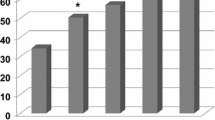Abstract
Background
Anastrozole and tamoxifen have mild toxicity. However, we noticed that more patients treated with anastrozole complained of joint symptoms than expected. In particular, digital stiffness as is seen with rheumatoid arthritis is a problem. Some clinical trials of anastrozole in Europe and the United States reported musculoskeletal disorders as adverse events, however, joint symptoms were not described in detail.
Patients and Methods
At our clinic from August 2001 to March 2005, 53 postmenopausal women with estrogen receptor-positive breast cancer were treated with anastrozole. We calculated the incidence and classified the grade of joint symptoms by interviewing patients. We also investigated the patients’ characteristics and their relevance to joint symptoms.
Results
Of 53 patients, 14 patients (26%) had joint symptoms (13 patients with digital stiffness and 3 patients with arthralgias of wrist and shoulders). Joint symptoms tended to occur in the patients who had previously undergone chemotherapy; however, there has no relationship between prior hormonal therapy and joint symptoms. Seven patients who discontinued anastrozole treatment showed improved symptoms. Five patients with grade 1 digital stiffness continued anastrozole treatment without additional treatment. Two patients with grade 1 digital stiffness, who took a Chinese herbal medicine showed improved symptoms and continued anastrozole treatment.
Conclusion
Benefits to the patients may possibly be lost by discontinuation of anastrozole or changing to tamoxifen since the clinical superiority of anastrozole to tamoxifen has been reported. We should continue anastrozole in patients with low grade symptoms, while ensuring that patients are aware of the toxicity of anastrozole.
Similar content being viewed by others
Abbreviations
- CTCAEver3.0:
-
Common terminology criteria for adverse events version 3.0
- MMP3:
-
Matrix metalloproteinase 3
References
Buzdar AU, Jones SE, Vogel CL, Wolter J, Plourde P, Webster A. A phase HI trial comparing anastrozole (1 and 10 milligrams), a potent and selective aromatase inhibitor, with megestrol acetate in postmenopausal women with advanced breast carcinoma.Cancer 79:730–739, 1997.
Jonat W, Howell A, Blomqvist C, Eiermann W, Winblad G, Tyrrell C, Mauriac L, Roche H, Lundgren S, Hellmund R, Azab M: A randomised trial comparing two doses of the new selective aromatase inhibitor anastrozole (Arimidex) with megestrol acetate in postmenopausal patients with advanced breast cancer.Eur J Cancer 32:A404–412, 1996.
Buzdar AU, Jonat W, Howell A, Jones SE, Blomqvist CP, Vogel CL, Eiermann W, Wolter JM, Steinberg M, Webster A, Lee D: Anastrozole versus megestrol acetate in the treatment of postmenopausal women with advanced breast carcinoma: results of a survival update based on a combined analysis of data from two mature phase HI trials. Arimidex Study Group.Cancer 83:1142–1152, 1998.
Baum M, Buzdar A, Cuzick J, Forbes J, Houghton J, Howell A Sahmoud T: Anastrozole alone or in combination with tamoxifen versus tamoxifen alone for adjuvant treatment of postmenopausal women with early-stage breast cancer: results of the ATAC (Arimidex, Tamoxifen Alone or in Combination) trial efficacy and safety update analyses.Cancer 98:1802–1810, 2003.
Howell A, Cuzick J, Baum M, Buzdar A, Dowsett M, Forbes JF, Hoctin-Boes G, Houghton J, Locker GY, Tobias JS: Results of the ATAC (Arimidex, Tamoxifen, Alone or in Combination) trial after completion of 5 years’ adjuvant treatment for breast cancer.Lancet 365:60–62, 2005.
Winer EP, Hudis C, Burstein HJ, Chlebowski RT, Ingle JN, Edge SB, Mamounas EP, Gralow J, Goldstein LJ, Pritchard KI, Braun S, Cobleigh MA, Langer AS, Perotti J, Powles TJ, Whelan TJ, Browman GP: American society of clinical oncology technology assessment on the use of aromatase inhibitors as adjuvant therapy for women with hormone receptor-positive breast cancer: status report 2002.J Clin Oncol 20:3317–3327, 2002.
The NCI Common Terminology Criteria for Adverse Events version 3.0:2003.
Tanizaki K, Takatani H, Mifune H,et al: Clinical effectiveness of Tsumura Keishika-jupputo for rheumatoid arthritis.Rinnsho To Kennkyu 70:2285–2292 (in Japanese).
Donnellan PP: Aromatase Inhibitors and Arthralgia.J Clin Oncol 19:2767, 2001.
Dombernowsky P, Smith I, Folkson G,et al: Letrozole, a new oral aromatase inhibitor for advanced breast cancer: Double-blind randomized trial showing dose effect and improved efficacy and tolerability compared with megestrol acetate.J Clin Oncol 16:453–461, 1998.
Goss PE, Winer EP, Tannock IF,et al: Randomized phase HI trial comparing the new potent and selective third generation aromatase inhibitor vorozole with megestrol acetate in postmenopausal advanced breast cancer patients: North American Vorozole Study Group.J Clin Oncol 17:52–63, 1999.
Jones S, Vogel C, Arckhipov A, Fehrenbacher L, Eisenbeg P, Cooper B, Honig S, Polli A, Whaley F, di Salle E, Tiffany J, Consonni A, Miller L for the Aromasin Study Group: Multicenter, phase II trial of exemestane as third-line hormonal therapy of postmenopausal women with metastatic breast cancer.J Clin Oncol 17:3418–3425, 1999.
Pansini F, Albertazzi P, Bonaccorsi G,et al: The menopausal transition: A dynamic approach to the pathogenesis of neurovagetative complaints.Eur J Obstet Gynecol Reprod Biol 57:103–109, 1994.
Yamanaka H, Matsuda Y, Tanaka M,et al: Serum matrix metalloproteinase 3 as a predictor of the degree of joint destruction during the six months after measurement in patients with early rheumatoid arthritis.Arthritis Rheum 43:852–858, 2000.
Christgau S, Garnero P, Fledelius C, Moniz C, Ensig M, Gyneyts E, Rosenquist C, Qvist P: Collagen type II C-telopeptide fragments as an index of cartilage degradation.Bone 29:209–215, 2001.
Author information
Authors and Affiliations
Corresponding author
About this article
Cite this article
Ohsako, T., Inoue, K., Nagamoto, N. et al. Joint symptoms: A practical problem of anastrozole. Breast Cancer 13, 284–288 (2006). https://doi.org/10.2325/jbcs.13.284
Received:
Accepted:
Issue Date:
DOI: https://doi.org/10.2325/jbcs.13.284




